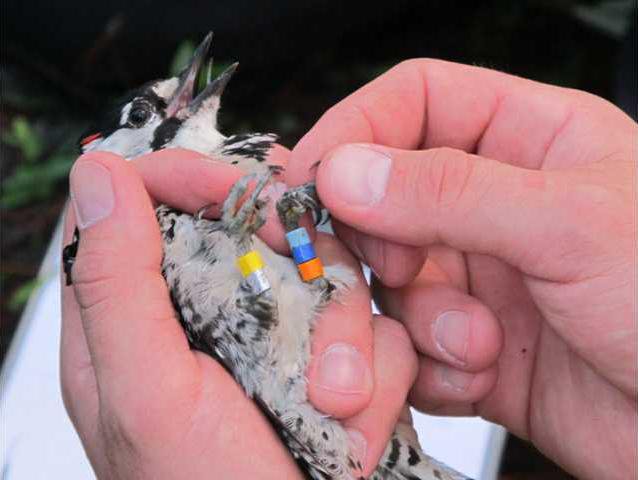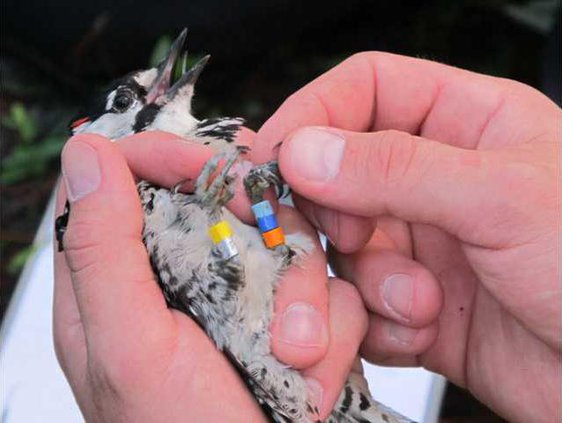The population of red-cockaded woodpeckers on Fort Stewart has more than doubled in the past 18 years, according to Larry Carlile, wildlife biologist supervisor with Fort Stewart’s Fish & Wildlife Branch of the Environmental & Natural Resources Division of the Directorate of Public Works.
“I started working here in 1994,” said Carlile, a graduate of the University of Georgia. “Back then, we had 157 active clusters. “Today, we have 383 active clusters, which include 351 potential breeding groups.”
Although still an endangered species in some areas of the Southeast, red-cockaded woodpecker populations on Fort Stewart are so healthy, Carlile said they have been able to relax some of the protections in some areas of the installation and give away juvenile birds for relocation efforts around the region.
Carlile, biologist Tommy Holland, intern biologist Chris Rentz and fish and wildlife branch chief Tim Beaty checked on one of the clusters early Friday morning, not far from Red Cloud Range. An hour before sunrise, they already had set nets mounted on 20-foot poles at the entrance to the five nest sites in that cluster.
As the sun began to peek through the tall stand of longleaf pines, one by one, the little woodpeckers tried to leave their nest only to be captured.
Holland and Rentz then checked each bird for banding. Juveniles with no bands were banded. Older birds with faded bands got new ones. Holland said the bands are color-coded to tell them where a bird originated.
“Most of the ones we band will stay close by,” he said. “But some have been found up to five miles away.”
Beaty said it is unusual for red-cockaded woodpeckers to move very far away though he recalled one bird banded at Fort Stewart that was caught near Apalachicola, Fla.
He said a cluster of birds usually range 150-200 acres. Noting that at least 136,000 of Fort Stewart’s 280,000 acres are prime woodpecker habitat, he said Stewart has room for twice the population it has now.
The distinctive red splash of feathers on the side of the bird’s head only is found on male birds, explained Beaty. Juvenile males have a larger red spot on the tops of their heads, which eventually fades away. Females have no red feathers at all.
Beaty and Carlile credit the collaborative effort with Fort Stewart’s forestry branch with helping to increase the bird’s population by increasing its habitat. Red-cockaded woodpeckers prefer old growth, longleaf pine forest with little undergrowth, which the forestry branch has been working hard to restore to Fort Stewart.
“It’s been a coordinated effort,” said Beaty, a Georgia Southern graduate who has been with Stewart’s Fish and Wildlife Branch since 1977. “They would come in and cut some trees or do a controlled burn, then we’d come in behind them and put up the artificial cavities.”
Carlile said the cavity or artificial nest is made with a chain saw. They cut a 4-inch square hole into the tree trunk high enough off the ground to avoid ground predators but well below tree limbs to avoid tree predators, especially snakes.
He said they hammer a 2-inch diameter pipe into the cavity then cover the excess hole around the pipe with a metal face plate to prevent other woodpecker species from “wallowing out” the hole. He said 1,850 artificial cavities already have been made.
Beaty said other endangered or threatened species found on Fort Stewart that his branch monitors include the frosted flatland salamander, wood stork, eastern indigo snake and the gopher tortoise.
“Reaching 351 potential breeding groups (of red-cockaded woodpeckers) is a crowning achievement,” Beaty said. “But we’re just as proud of the 129 PBGs we’re able to (relax protection levels) for.”
In March 2010, Beaty’s team received the U.S. Fish and Wildlife Service’s 2009 Military Conservation Partner Award, partly for its success at increasing populations of red-cockaded woodpeckers.
Woodpecker populations increase on post


Sign up for our e-newsletters